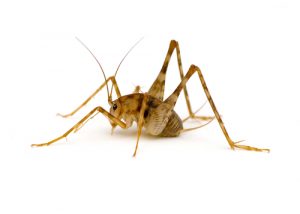“Jumping Spiders” Are Really Camel Crickets
By Chris Williams on January 6, 2012.
Q. We have these very strange insects in our basement. They’re light brown, about an inch long with very long legs. They look kind of like a spider but they jump—a lot, and high. I find them just downstairs and mostly around the outside door to the basement and in the hot water heater closet. When I open the door to that closet, they start jumping at me and scare me to death! Is this some kind of a jumping spider and why do I have so many?
A. There are jumping spiders but they’re not that big and they tend to make short jumps horizontally to capture prey, not high jumps. The size and the fact that you’re finding them in probably the dampest part of your basement suggests that they might be camel crickets.
Describing it as looking like a spider is also a clue. People often describe the camel cricket that way because of its long legs and the fact that its humped back makes it look shorter and rounder than other crickets. It’s about one inch long and a mottled, two-tone, light brown color. In addition to its extra long hind legs, it has extremely long antennae. If you find a dead one that you can look at up close, you’ll see that, although it doesn’t look like the typical black field cricket, it does have the large hind legs of a cricket and it has only 6 legs (spiders have 8).
 The camel cricket is an occasional invader of homes. Outside, it lives in dark, moist places: under stones or logs, in caves, in animal burrows, in drain pipes, or in hollow trees. In late summer, people start to notice camel crickets in sheds and garages. They jump at the least little disturbance. In fall, you can sometimes open the door to an outdoor shed and it sounds like popcorn popping with all the camel crickets bouncing off of the walls! In fall or during hot, dry weather, they sometimes find their way into homes where they end up in dark, cool, damp areas inside. That usually means lower level crawlspaces and basements. Camel crickets are rarely found in upper level living areas. They can be found in laundry rooms, utility rooms, or shower stalls, or in cardboard boxes stored on the floor, in stacks of newspapers, old books, or other paper products, in stored clothing or rags, and in stacked firewood. You probably have what seems like a lot of camel crickets because you have openings that allow them to get inside, and once inside they concentrate together in the few damp, dark areas.
The camel cricket is an occasional invader of homes. Outside, it lives in dark, moist places: under stones or logs, in caves, in animal burrows, in drain pipes, or in hollow trees. In late summer, people start to notice camel crickets in sheds and garages. They jump at the least little disturbance. In fall, you can sometimes open the door to an outdoor shed and it sounds like popcorn popping with all the camel crickets bouncing off of the walls! In fall or during hot, dry weather, they sometimes find their way into homes where they end up in dark, cool, damp areas inside. That usually means lower level crawlspaces and basements. Camel crickets are rarely found in upper level living areas. They can be found in laundry rooms, utility rooms, or shower stalls, or in cardboard boxes stored on the floor, in stacks of newspapers, old books, or other paper products, in stored clothing or rags, and in stacked firewood. You probably have what seems like a lot of camel crickets because you have openings that allow them to get inside, and once inside they concentrate together in the few damp, dark areas.
Camel crickets scavenge on a wide range of foods including fruits, vegetables, pet food, and dead insects. They can also feed on and damage papers, including wallpaper, and fabrics. The good news is that, unlike the field cricket and the house cricket, the camel cricket does not chirp, does not fly, is not attracted to lights (although they are active at night), and generally doesn’t survive long in the drier indoor air.
Reducing moist hiding areas (both inside and out) will reduce camel cricket problems. Outside, get rid of wood and debris piles or raise them up off of the ground, and remove leaves, mulch, and weeds around the foundation. In basements, garages, and sheds, cardboard boxes and other damp materials should be stored on shelves rather than on the ground. Install door sweeps or thresholds under basement and garage doors, and screen crawlspace vents. Or, give Colonial a call. Our trained pest control technicians can do that pest-proofing for you. Our management program includes sealing openings that camel crickets are using to get inside, and our semi-annual foundation treatment will help to stop them in their tracks.